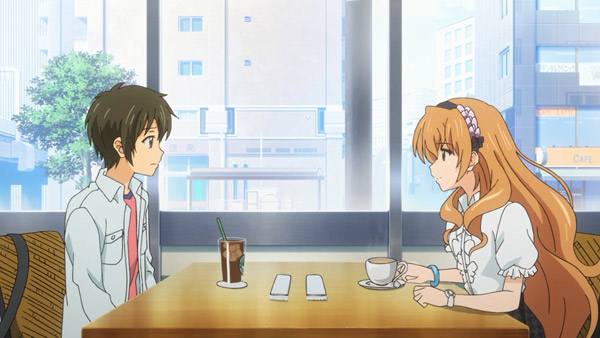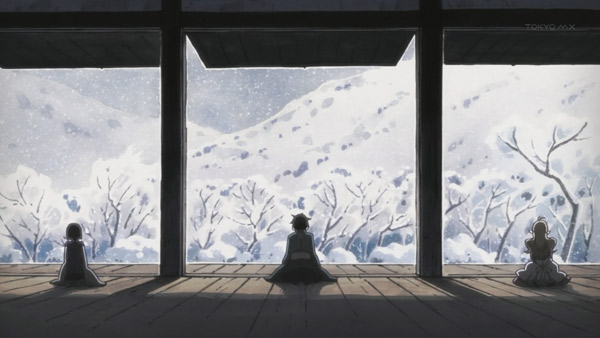
After finding the photo of him with Linda, Banri visits the bridge where he was injured. Kouko declares him a “great friend”, and next morning is acting strange again; too enthusiastic. She and Banri join the festival club, but Kouko struggles with dancing. She bursts into tears, but later apolgizes to Banri for taking advantage of his kindness. In a flashback, the “past” Banri recalls seeing a light in the forest from his hospital room. He escapes and checks it out, and bumps into Linda, whom he doesn’t recognize. Linda doesn’t lead on that he knows her, but she still convinces him to go to Tokyo and start over.
Well…we weren’t expecting any of that! Not that that’s a bad thing; we prefer being surprised to knowing how things are going to proceed – as long as no sharks are jumped. It turns out we were a little premature in celebrating Banri’s confession to Kouko, and with good reason: turns out that wasn’t the perfect time to do so. Kouko is only two days removed from the Mitsuo incident; her emotions are still confused, and if she’s honest – and to her credit, she’s extremely honest throughout this episode – they were confused before, too. She still feels hopeless, and so she’s willing to take whatever kindness and understanding comes her way. But yeah, even she knows by expressing her hope she and Banri can be good friends, she’s essentially rejecting the guy, at least for the time being. Banri is disappointed, but for much of the episode he’s preoccupied with that photo of him with Linda.
Who was she to him, and why is she acting like they just met? As soon as he found that photo, we wanted Banri to simply confront Linda and ask her these question, with the same resolve with which he stepped up and confessed to Kouko. We can take a guess why: it could be Linda’s way of “respecting” the “New Banri.” Whatever her relationship was with him, that was a different person. The show makes a very interesting choice in providing us with answers New Banri isn’t privy to, courtesy of the bodiless “Old Banri”, a device which works for us. The flashback not only confirms that Linda cared a great deal for Banri, but we’re given more evidence for why she’s stayed mum about knowing Banri: in that flashback, he vows to cast away all his old bonds…and though he doesn’t know it, she’s one of them.

Rating: 8 (Great)
Stray Observations:
- Kouko demonstrates that when you’re “good friends” with her, you’d better be prepared to take the good with an occasional side of crazy. The latter is a part of her; it didn’t vanish just because Mitsuo abjured her.
- The flashback builds on the cold open of episode two, when Banri was walking through the forest. Though this time, it’s not Kouko beyond the light, but Linda.
- We really dig past Linda’s hairstyle. Wonder if changing her hair had something to do with wanting to “start over” once what happened to Banri happened.
- We see that Linda has a motorbike. Was that supposed to make us think she was the one who ran him over in the first place? WHY ARE WE THINKING THAT?!















